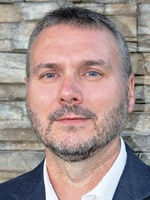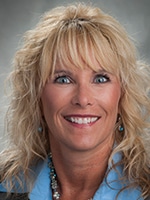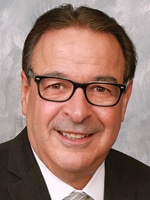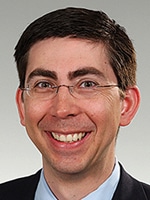May 2022—Opening and expanding schools—the path to a labor pool for labs. Compass Group members continue to move on that as they experiment with other solutions. “We’re exploring every avenue to bridge the staffing gap,” said Dhobie Wong of Sutter Health in a virtual roundtable with CAP TODAY publisher Bob McGonnagle on April 5. Here is more of what she and others said, including about digital pathology, hiring pathologists, and installing Beaker.
The Compass Group is an organization of not-for-profit IDN system laboratory leaders who collaborate to identify and share best practices and strategies.
Joe Baker, we’ve been talking about the staffing shortage for at least a year. You have been among many who have talked about the need to start your own school, train your own people. Where are you now in your efforts, and is your staffing situation any better?

Baker
Joseph Baker, VP of laboratory, Baylor Scott & White Health, Dallas: We’ve received approval to expand the medical laboratory sciences school in our central Texas region. We’re expanding that student base because we get enough applicants, which has been surprising. We’re hoping to expand to a couple of sites in our north Texas regions this year with the goal of expanding further in years to come. We are trying to get our phlebotomy and laboratory technologist training programs off the ground; we expect to have our first class around July. We’re trying to build a foundation and hire the appropriate people to teach and train.
We’re struggling with staffing. It’s not just about not having qualified candidates; it’s also trying to ensure people don’t leave the system. We’re worried about and focused on the morale and health of the team. We’re cognizant of the struggles and are developing ideas and implementing actions around these areas.
Wendy Kleckler at ACL, where are you with staffing?

Kleckler
Wendy Kleckler, VP of business development, ACL Laboratories, West Allis, Wis.: Our staffing is short everywhere in the medical laboratory technician world and in phlebotomy. We have phlebotomy and histology schools, so we have the opportunity to pull those people in, but not nearly enough in terms of volume. The market is competitive, so when you raise your minimum, your neighbor raises their minimum; you have a sign-on bonus, they double your sign-on. We continue to partner with human resources and our talent teams to identify opportunities, but we’re still short several hundred technicians.
Are you using staffing agencies?
Wendy Kleckler (ACL Laboratories): We have used some but your budget takes a hit. We have used them in northern Wisconsin, where it’s hard to find candidates but there are some agency staff. Otherwise we’re working short, unless we can’t—then we’ll employ agency.
Dhobie Wong, tell us what you’re doing about staffing.
Dhobie Wong, MBA, MLS(ASCP), CLS, VP of laboratory services, Sutter Health, Sacramento, Calif.: We’re exploring every avenue to bridge the staffing gap. We’re looking at using more medical laboratory technicians in the laboratory to bridge the duties and responsibilities from our clinical laboratory scientists team.
Even with the MLTs there’s still a shortage within California, so we’re looking to partner with schools or expand our teaching. We have partnered with schools for clinical laboratory scientists. We’re seeing if there are ways we can optimize our unlicensed staff, like lab assistants, and what duties and responsibilities they can fill with skills-mix optimization.
We’re also exploring a centralized fulfillment center, an approach widely used in nursing. Our fulfillment center provides short-term and crisis staffing solutions using a hub-and-spoke model for multiple sites. We’re looking into whether it’s feasible within our laboratory structure. There’s groundwork to be done, trying to get operationally standardized and more alignment so it’s easier to shift staff to where we have a need.
One of the main topics at the USCAP meeting was pathologist staffing. Peter Dysert, can you elaborate on where you are within Baylor Scott with the pathologist shortage and trying to hire?
Peter Dysert, MD, chief, Department of Pathology, Baylor Scott & White Health, Dallas: We’re recruiting people now. We’ve had a number of people choose to retire, many of whom were senior and experienced pathologists. We’ve struggled to find candidates who would fit our academic-style practice. A lot of people are prioritizing what I would say is closer to pure private practice. With the 400-plus multidisciplinary conferences we do a year, the overhead that training residents represents seems to be a bigger challenge. We’ve managed to hire a couple of people, but we’re still looking for people who will thrive in our academic practice environment. I’ve been visiting with other colleagues around the country who are in a similar situation.
Lauren Anthony, last month you told us about difficulties with the blood supply and supply chain. Has the situation improved?
Lauren Anthony, MD, system laboratory medical director, Allina Health, Minneapolis: The Red Cross told us the blood supply is stabilized. We have been monitoring it, and we still have our contingency planning. The tube supply seems to have stabilized, so we’re able to resume use of some light green–topped tubes, which we had restricted. We’re still having command-center meetings to monitor the supply and make sure we ease controls on the utilization gradually based on inventory. We’re thinking ahead for strategy.
Sam Terese, you run an enormous enterprise at Alverno. What’s top of mind for you?

Terese
Sam Terese, president and CEO, Alverno Laboratories, Indiana and Illinois: Staffing is probably our number one concern. We are spending significant dollars for agency and overtime. The numbers are quite large to cover our open positions. I think our only way out is to build our own labor pool. We’re opening more schools. We have three schools active now, and we’re opening a fourth in the next few months. We have an active histotechnology program to try to keep up with demand. We have rapid tech training programs in which we take people with bachelor’s degrees and turn them into techs in 90 days for our automated and rapid response laboratories.
A new concern garnering attention here is inflation impact with supply chain lines. We’ve started digging through our contracts to understand what kinds of consumer price/medical price index increases are built into them and what exposure to cost increase we might experience. We are getting ready for that wave of cost that will probably be coming across our desks in the next several months.
We’re looking at automation investments where we wouldn’t necessarily have made them in the past. We’re starting to look at what the returns on investment would look like in our smaller organizations, our 200-bed hospitals, where we wouldn’t consider automation in the past. There’s an opportunity to stem the staffing demand from that perspective as well.
Our experience with finding pathologists is similar; we’re having difficulties.
You were mentioned frequently at the USCAP meeting for your prescient adoption of digital pathology. Can you give us an update about how that’s going and if it is fulfilling promises according to the schedule?
Sam Terese (Alverno): We are still rolling out a couple of sites. We got sidetracked with COVID and didn’t visit a lot of locations to do that final training sign-off. We lost a little ground as we had challenges with computer chips, for example. But most of our sites are live and reading.
So far from the initial phase, which was primary screening, the immunohistochemistry and special stains, that work is moving forward and we’re starting on the artificial intelligence initiatives. We’re working with a couple of partners, Ibex being one of them. There’s a team of pathologists and forward-thinkers who are working through initial AI deployment potentials. We hope by year-end to have something out there. So far, so good—it’s doing everything we hoped it would. The only challenge is from an ROI perspective; it continues to present challenges for many. Given our centralized histology model, we have a bit of an advantage.
Greg Sossaman, tell us what you’re thinking as we talk about digital pathology and the pathologist shortage.

Dr. Sossaman
 CAP TODAY Pathology/Laboratory Medicine/Laboratory Management
CAP TODAY Pathology/Laboratory Medicine/Laboratory Management
